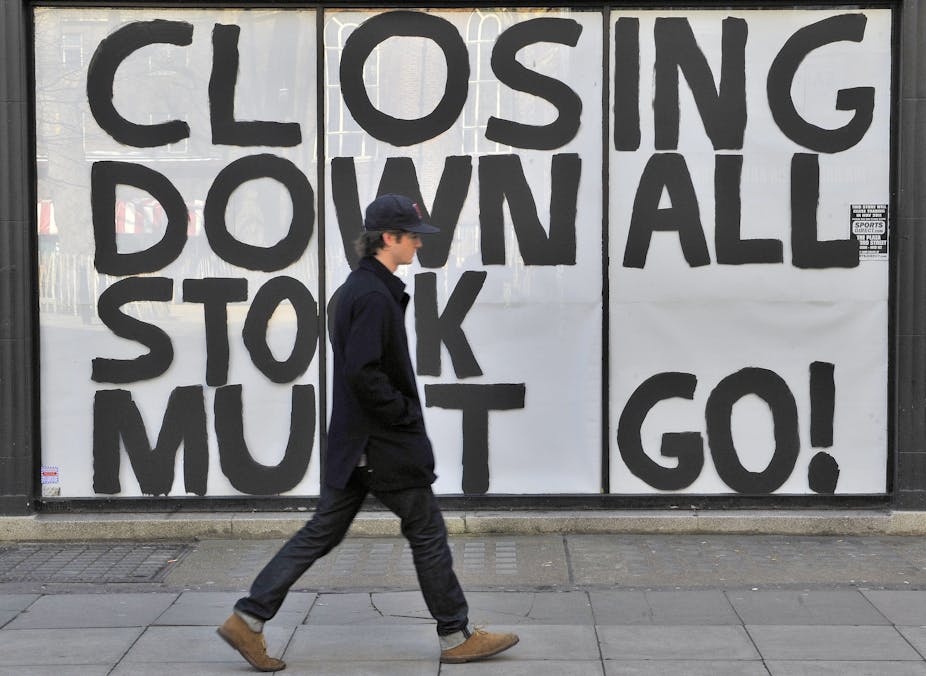Like Australia, the United Kingdom accords a particular value to home ownership that extends beyond the mere provision of housing.
We British like to think of ourselves as a “property-owning democracy” and our politicians saw the rise of the tenure throughout the last century as evidence of widening opportunities and the spread of wealth.
However, allowing house prices to rise faster than earnings will price more and more people out of housing. And that is precisely what has happened in the UK.
British Department of Communities and Local Government figures show house prices in the mid-1990s were some 3.5 times average earnings. Now, even after some falls, they stand at seven times earnings. So it’s no surprise that ownership has been falling among the young – and now not so young.
“End of the affair”
Only recently is it becoming clear that this may not be a blip, but the start of a reversal in the trend – as one commentator put it, “the end of the affair”.
In truth, the sickly nature of the UK housing market has been evident for decades. It is persistently volatile, having experienced four boom and bust cycles over the past four decades. Volatility brings its own chaos.
Individuals are tempted to enter and over-extend themselves in upswings, but find themselves trapped in negative equity in downswings.
Downswings combine with the economic cycle to turn mortgage arrears into foreclosure crises – since 1980 some 840,000 UK households have experienced foreclosure.
The social consequences of boom and bust force governments into making costly knee-jerk interventions to stabilise the market, no matter what they said to the contrary in the boom.
Meanwhile, regional differences in house price inflation inhibit labour mobility by making it difficult for people to move from low cost areas to high cost areas, while those in high inflation areas are reluctant to move to low inflation areas for fear of never being able to return.
Mortgage lenders are as bemused as individual households, unclear whether they are merely meeting demand or leading the market into unsustainable boom.
Boom and bust
When the downturn comes, excessive conservatism takes over – until the cycle is repeated.
Ultimately, the boom/bust cycle reduces the capacity of housebuilders to respond to new demand – with the result that today we have a huge affordability problem combined with the lowest level of housebuilding since 1923.
The Joseph Rowntree Foundation’s Housing Market taskforce was established to seek long-term solutions to house price volatility.
It’s report, published in May 2011, outlined a series of recommendations to improve the supply of housing, which was identified as being fundamental to tackling volatility in the long run.
Taxation reform
The Taskforce also suggested that the reform housing taxation could be used to tackle the boom/bust cycle.
The UK has a form of property taxation called the Council Tax which is used to finance a minority of local government services – most funding now comes in the form of a grant from central government.
Properties are placed into eight bands according to the property’s value – in 1991! It is unfair because the banding system is designed to ensure that cheaper properties are taxed more heavily than expensive ones.
It is also regressive between regions, with the highest priced areas being less heavily taxed than the low cost ones. It is not counter cyclical because it essentially raises a fixed sum to pay for local services.
Thus during the long period of rising house prices until 2008, Council tax as a proportion of property values fell from 0.7 per cent to 0.5 per cent.
But the Council Tax could be reformed to overcome these deficiencies to turn it into a tool with which to counter house price volatility. This could be achieved gradually over time.
First the number of bands in the Council Tax could be increased, and revaluations take place more frequently. We could then shift to a ‘point value’ system based on property values in place of bands.
This would increase the relationship between property value and tax liability. Third, the central government grant to local authorities could be adjusted so that it falls in areas where prices rise and rises in areas where prices fall.
Eventually the link between the tax and local government could be broken and the tax become a national property tax allowed to rise and fall according to price movements.
Rebate system
A rebate system would need to be established to protect the “income poor but asset rich”.
As Oxford economist John Muellbauer has argued, such a system would provide a counter-cyclical balance to the housing market cycle, as the tax would represent a higher proportion of the cost of housing services as prices rose and a smaller proportion as they fell.
The Taskforce concluded that more work would need to be done to establish the benefits of such as system, but it seems likely that a property tax is likely to form a part of any serious anti-volatility strategy.
Mark Stephens is a guest speaker at Improving housing affordability through tax reform: Australia and the UK in comparison seminar in Sydney today, organised by the Australian Housing and Urban Research Institute.

